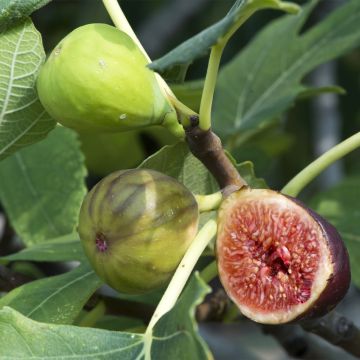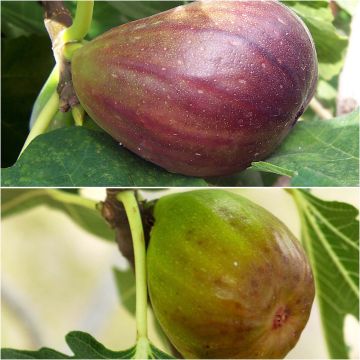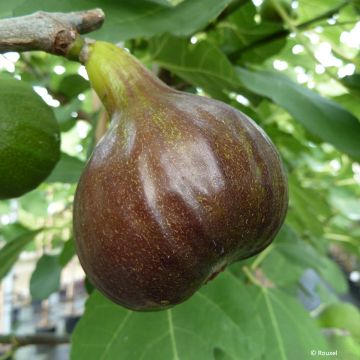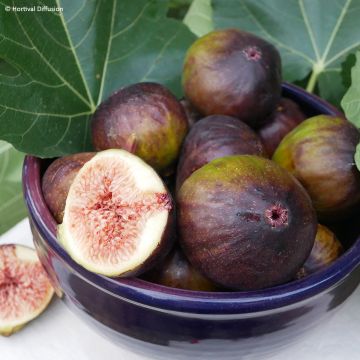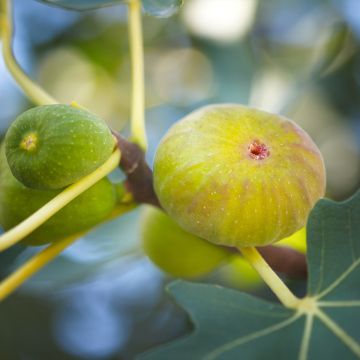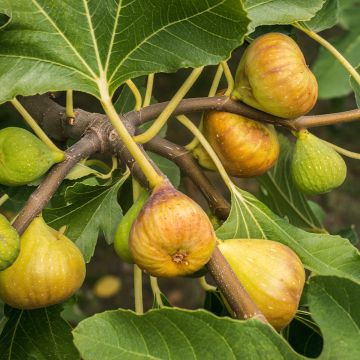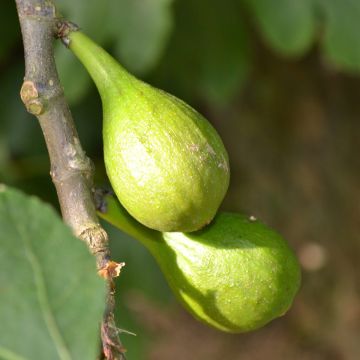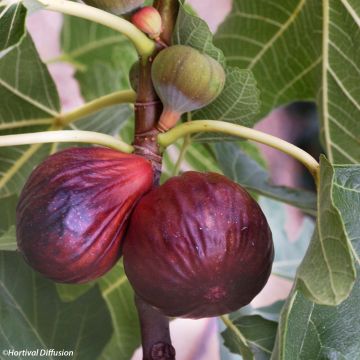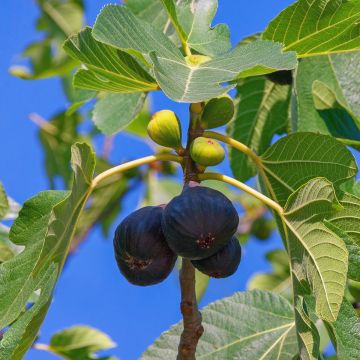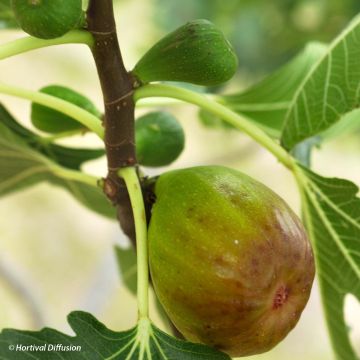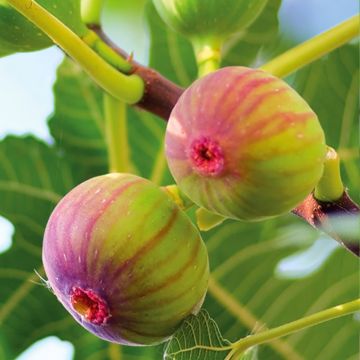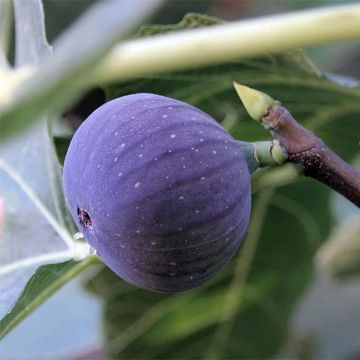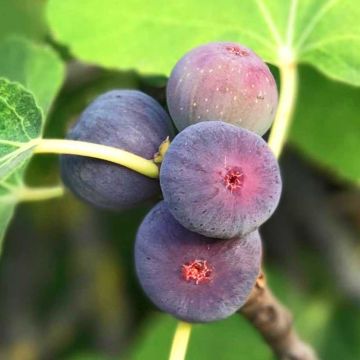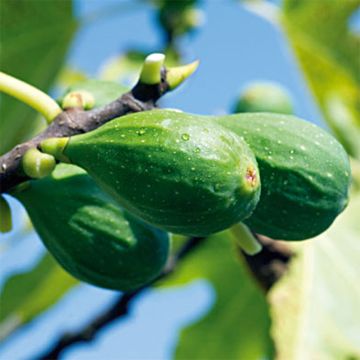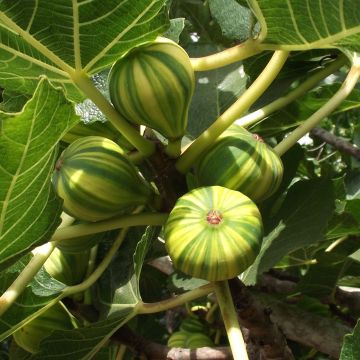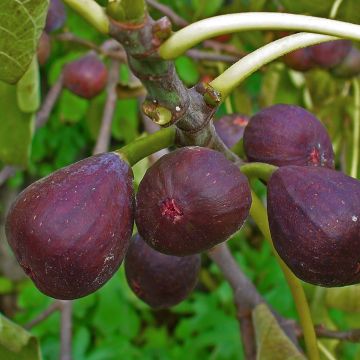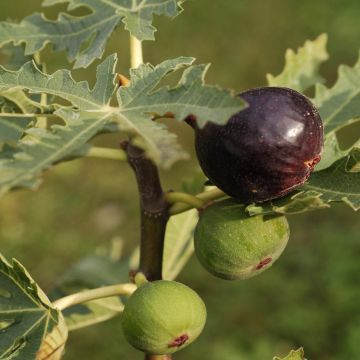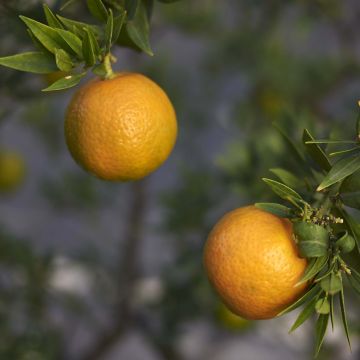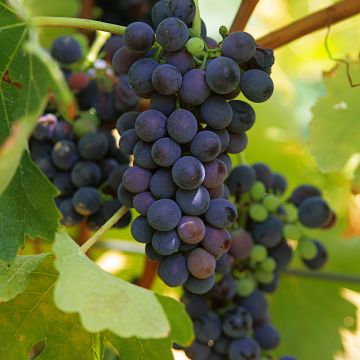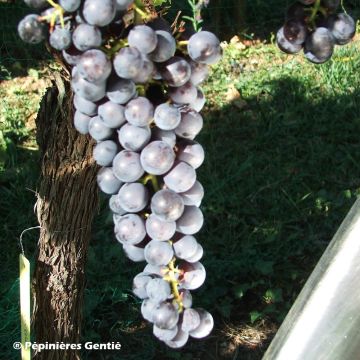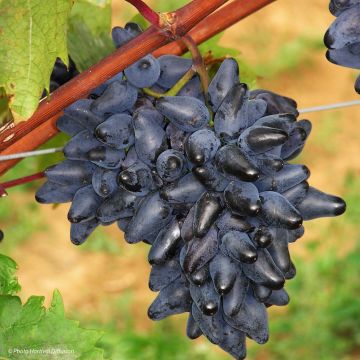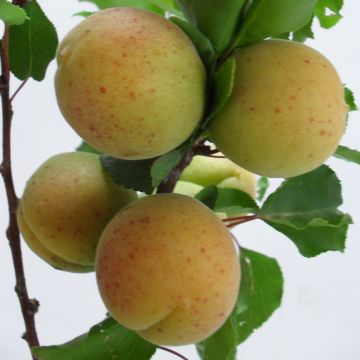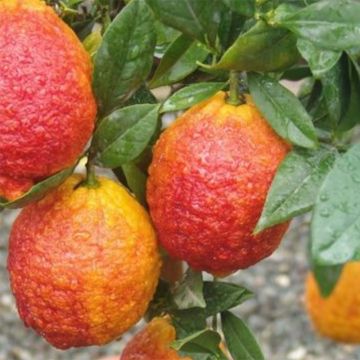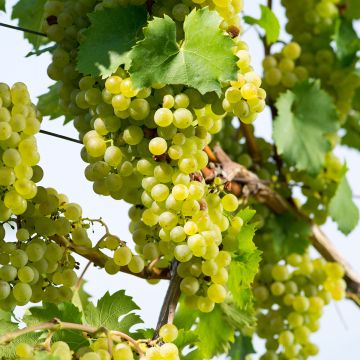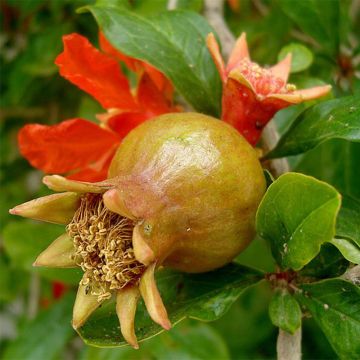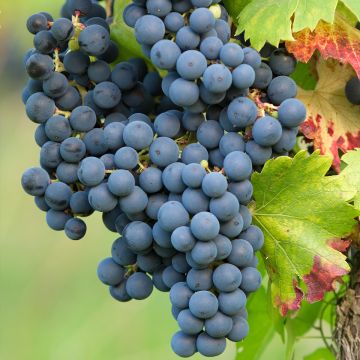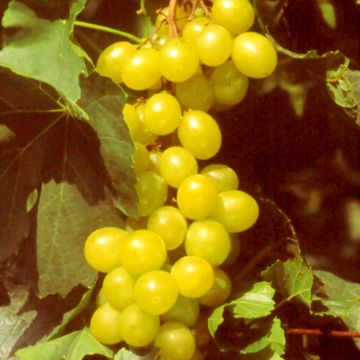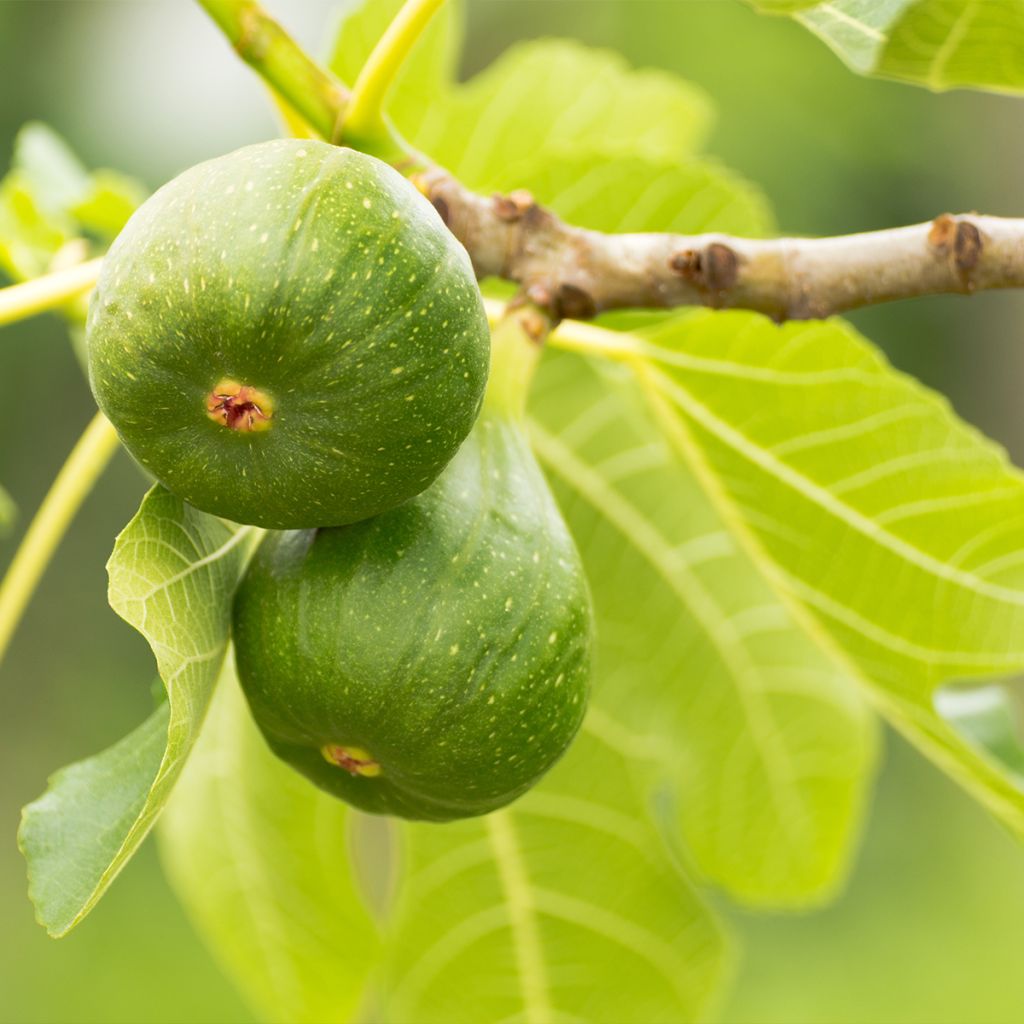

Fig Tree Jannot - Ficus carica
Fig Tree Jannot - Ficus carica
Ficus carica Jannot
Common Fig, Fig Tree
Why not try an alternative variety in stock?
View all →This plant carries a 6 months recovery warranty
More information
We guarantee the quality of our plants for a full growing cycle, and will replace at our expense any plant that fails to recover under normal climatic and planting conditions.
Oversize package: home delivery by special carrier from €6.90 per order..
Express home delivery from €8.90.
From €5.90 for pickup delivery and €6.90 for home delivery
Express home delivery from €8.90.
Delivery to Corse prohibited: UE law prohibits the import of this plant from mainland France to Corse as part of the fight against Xylella fastidiosa. Please accept our sincere apologies.
More information
Description
Ficus carica Jannot is a hardy, vigorous, self-fertile and highly productive variety. This Fig tree bears fruit twice a year, once in July and again in September-October. The fruits have a yellowish-green skin, large in size, with juicy red flesh and a sweet and fragrant flavour. They are highly appreciated when eaten fresh, cooked in dishes, or dried. The Fig is a delightful summer fruit with numerous nutritional benefits. Its average growth and distinctive foliage make the Jannot Fig tree a highly decorative and charming shrub. Plant it in autumn-winter, frost-free conditions (or in spring for colder regions).
The Ficus carica Jannot is a recent variety, originating from Maine-et-Loire. It is named after the gardener who cultivated it.
Originally from regions with a warm temperate climate, ranging from the Mediterranean to Central Asia, the Fig tree belongs to the Moraceae family. Generally, it grows up to three to four metres in height and has a twisted trunk and a bushy habit. The deciduous leaves are rough and hairy, reaching up to 25 cm (10in) in length, with three to seven lobes that are serrated and vary in shape. The undersides of the leaves are velvety and show prominent veins. The stems, leaves, and fruits contain a white latex that can cause irritation. The wood, with its smooth gray bark, is soft, spongy, and hollow. The Fig tree has strong, trailing roots.
There are two types of Fig tree: unifere varieties that produce one abundant harvest per year, usually in early autumn, and biferous varieties that bear fruit twice a year. The first harvest consists of 'fig-flowers' in the summer on the previous year's branches, and the second harvest is the normal figs that develop in autumn on the current year's growth.
Among all the varieties of Fig tree, the Jannot Fig tree is a biferous variety. It produces an abundant first harvest in July with figs weighing around 80 to 100g, and a second harvest in October-November with figs weighing 40 to 70g. This staggered fruiting ensures a continuous supply of delicious figs throughout the season. Multiple pickings are required for the figs to ripen fully and be consumed at their maximum flavour. Ficus carica Jannot is a self-fertile and parthenocarpic variety, meaning it can produce fruit without pollination. It does not require other Fig trees for pollination and does not rely on the blastophagus wasp, the Fig tree's sole pollinator, which is too sensitive to survive in cold climates.
Sun-drenched, figs can be enjoyed fresh, revealing their full flavour and succulence. They can also add a surprising touch to sweet dishes such as tarts, clafoutis, and compotes, as well as savoury dishes when paired with goat cheese, cured ham, or foie gras. They can also be served alongside poultry or white meats. The delicate and pronounced flavor of figs pairs well with honey. They also complement sweet fruits like cherries, strawberries, raspberries, blackberries, currants, blueberries, and grapes. Among fruits used for making jams, figs have a prominent place due to their delicate and rich flavor. They are very mild and rich in fibre, with laxative properties, and the seeds aid digestion. They are also rich in minerals, trace elements, and vitamin B. After harvesting, it is not recommended to refrigerate figs to avoid compromising their flavour and texture due to humidity and condensation.
The Fig tree is often considered one of the most beautiful fruit trees. Its distinctive foliage adds an ornamental touch and provides pleasant shade during hot summer days. Plant the Fig tree against a wall to protect it from the cold during harsh winters, with a south or southwest exposure. In southern regions, it can be planted alongside Pomegranate, White Mulberry, and Japanese Medlar. In colder regions, it can be associated with Quince, Feijoa, and Akebia quinata, which are also hardy and exotic. Take into account its adult size when determining the planting distance. Although the roots do not cause damage to modern constructions, they can damage dry stone walls or walls made with weak mortar in traditional construction methods.
Report an error about the product description
Fig Tree Jannot - Ficus carica in pictures
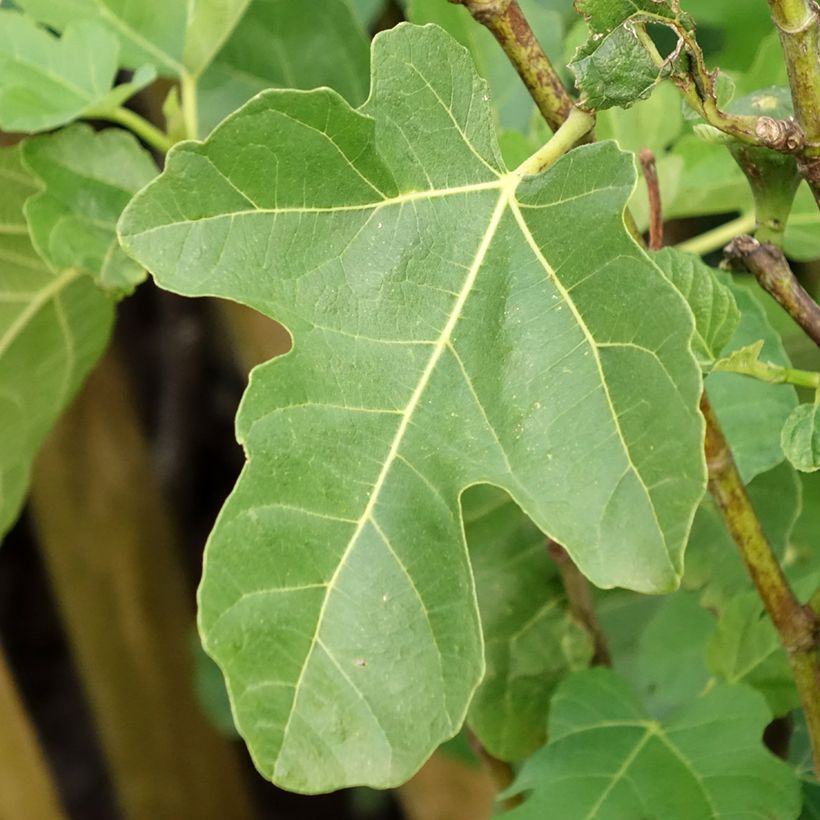

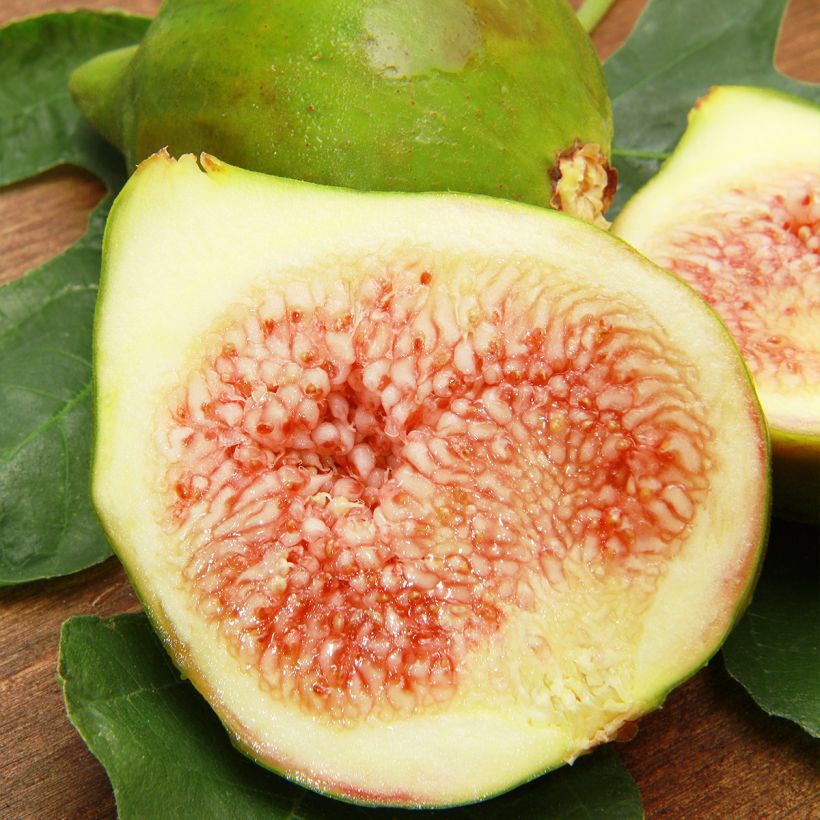

Plant habit
Fruit
Flowering
Foliage
Botanical data
Ficus
carica
Jannot
Moraceae
Common Fig, Fig Tree
Cultivar or hybrid
Other Fig trees
Planting and care
The Fig Tree adapts to all types of soil, even poor, rocky, and dry, or even rocky, but prefers deep, loose soil with a sufficiently high limestone content. It requires a sunny and sheltered position from strong winds. At the time of planting, create a layer of gravel at the bottom of the planting hole and add a mixture of garden soil and well-rotted compost or soil.
During the first two years following planting, it will be necessary to ensure that it does not lack water, especially in the summer, as its root system, although capable of drawing water deeply from the soil, is not sufficiently developed. It is not well-suited to montane climates, where its success is a challenge. It can be planted from November to the end of March, outside of freezing periods. In colder regions, it is preferable to plant early in the spring. It is a hardy tree, even if the aboveground parts can be destroyed by the cold (young branches from -15-17°C (5-62.6°F), flower buds from -10-12°C (14-53.6°F)), it will regrow from the stump until -20°C (-4°F).
The Fig Tree is not very susceptible to diseases and pests.
Planting period
Intended location
Care
This item has not been reviewed yet - be the first to leave a review about it.
Mediterranean fruit trees
Haven't found what you were looking for?
Hardiness is the lowest winter temperature a plant can endure without suffering serious damage or even dying. However, hardiness is affected by location (a sheltered area, such as a patio), protection (winter cover) and soil type (hardiness is improved by well-drained soil).

Photo Sharing Terms & Conditions
In order to encourage gardeners to interact and share their experiences, Promesse de fleurs offers various media enabling content to be uploaded onto its Site - in particular via the ‘Photo sharing’ module.
The User agrees to refrain from:
- Posting any content that is illegal, prejudicial, insulting, racist, inciteful to hatred, revisionist, contrary to public decency, that infringes on privacy or on the privacy rights of third parties, in particular the publicity rights of persons and goods, intellectual property rights, or the right to privacy.
- Submitting content on behalf of a third party;
- Impersonate the identity of a third party and/or publish any personal information about a third party;
In general, the User undertakes to refrain from any unethical behaviour.
All Content (in particular text, comments, files, images, photos, videos, creative works, etc.), which may be subject to property or intellectual property rights, image or other private rights, shall remain the property of the User, subject to the limited rights granted by the terms of the licence granted by Promesse de fleurs as stated below. Users are at liberty to publish or not to publish such Content on the Site, notably via the ‘Photo Sharing’ facility, and accept that this Content shall be made public and freely accessible, notably on the Internet.
Users further acknowledge, undertake to have ,and guarantee that they hold all necessary rights and permissions to publish such material on the Site, in particular with regard to the legislation in force pertaining to any privacy, property, intellectual property, image, or contractual rights, or rights of any other nature. By publishing such Content on the Site, Users acknowledge accepting full liability as publishers of the Content within the meaning of the law, and grant Promesse de fleurs, free of charge, an inclusive, worldwide licence for the said Content for the entire duration of its publication, including all reproduction, representation, up/downloading, displaying, performing, transmission, and storage rights.
Users also grant permission for their name to be linked to the Content and accept that this link may not always be made available.
By engaging in posting material, Users consent to their Content becoming automatically accessible on the Internet, in particular on other sites and/or blogs and/or web pages of the Promesse de fleurs site, including in particular social pages and the Promesse de fleurs catalogue.
Users may secure the removal of entrusted content free of charge by issuing a simple request via our contact form.
The flowering period indicated on our website applies to countries and regions located in USDA zone 8 (France, the United Kingdom, Ireland, the Netherlands, etc.)
It will vary according to where you live:
- In zones 9 to 10 (Italy, Spain, Greece, etc.), flowering will occur about 2 to 4 weeks earlier.
- In zones 6 to 7 (Germany, Poland, Slovenia, and lower mountainous regions), flowering will be delayed by 2 to 3 weeks.
- In zone 5 (Central Europe, Scandinavia), blooming will be delayed by 3 to 5 weeks.
In temperate climates, pruning of spring-flowering shrubs (forsythia, spireas, etc.) should be done just after flowering.
Pruning of summer-flowering shrubs (Indian Lilac, Perovskia, etc.) can be done in winter or spring.
In cold regions as well as with frost-sensitive plants, avoid pruning too early when severe frosts may still occur.
The planting period indicated on our website applies to countries and regions located in USDA zone 8 (France, United Kingdom, Ireland, Netherlands).
It will vary according to where you live:
- In Mediterranean zones (Marseille, Madrid, Milan, etc.), autumn and winter are the best planting periods.
- In continental zones (Strasbourg, Munich, Vienna, etc.), delay planting by 2 to 3 weeks in spring and bring it forward by 2 to 4 weeks in autumn.
- In mountainous regions (the Alps, Pyrenees, Carpathians, etc.), it is best to plant in late spring (May-June) or late summer (August-September).
The harvesting period indicated on our website applies to countries and regions in USDA zone 8 (France, England, Ireland, the Netherlands).
In colder areas (Scandinavia, Poland, Austria...) fruit and vegetable harvests are likely to be delayed by 3-4 weeks.
In warmer areas (Italy, Spain, Greece, etc.), harvesting will probably take place earlier, depending on weather conditions.
The sowing periods indicated on our website apply to countries and regions within USDA Zone 8 (France, UK, Ireland, Netherlands).
In colder areas (Scandinavia, Poland, Austria...), delay any outdoor sowing by 3-4 weeks, or sow under glass.
In warmer climes (Italy, Spain, Greece, etc.), bring outdoor sowing forward by a few weeks.

































